Notes: well, I absentmindedly did a 'Moche wave motif' search, and found some things!...this I've often seen:

Stirrup-Spout Vessel, 200 to 600 AD. Peru Culture, Moche Medium Period, Ceramic. Dimensions- Length (22.6 cm), Height (20.4 cm), Width (9.9 cm), 770g.
https://www.pinterest.com/pin/494340496582343287/?lp=true
unquote
from a pinterest page which I can't source further...before seeing this one, again, part of my step fret collection!, I was looking at this one:...
quote

The so-called step motif in which the hypotenuse of a triangle consists of steps (or a wavy line). These steps are probably a symbol for the mountain and/or the temple. Other triangles on such vessels are often filled in with small circles. A variant and extension is the step-wave motif. Here the vertical line of the triangle ends in a wave which curls either over the steps or backwards. The symbolism here is probably that of river water streaming down the mountains.
(text in bold is my emphasis)
... ... ...
BUT: at the same time we are also dealing with a completely different motif, belonging to the zoomorphic representations. What we are looking at from this point of view is the symbolic representation of the head of a catfish.
... ... ...
Quite often the head alone, seen from above, is depicted and usually this is done by composing it of geometric designs such as the step motif, as in our case. The small circles represent the eyes and the vertical lines that divide the panels are the feelers. What at first sight appeared to be the buff background for the tan geometric decoration now suddenly becomes the foreground. Quite remarkable!
https://www.alexanderancientart.com/584.php
unquote
that from an auction/seller site...note optical illusion...curator's caption cued me to the angle, the hypotenuse, of the steps...I hadn't considered that...and too how the steps morph into the curl...very distinctive in the first top pic of stirrup jar step fret...that, I'd say, is a 'tocapu paired elements'...and then, looking at the step fret vessel, and carrying over, following on, with my thoughts from yesterday about gnomic growth, the Egyptian box within a box, throne, I noted the triangle within a triangle!...go figure...this post like sixtysixth in a series...see previous...I dunno about the catfish bit...that maybe so...but could be snake/serpent/dragon/frog/strombus monster!...the two small square bumps make me think, strombus monster!...its eye stalks...misspelled that 'stocks' yesterday...but that kind of fits...rifle stock...I'm wondering if the mace head staffs, a pole with a round end, could be a play on mollusk antennae, which is what the Strombus Monster has...they are like little poles with round ends like the maces...thinking along like a Moche might, I imagine!, these maces could represent sight, or seeing...it's remarkable the Moche would stylize symbolize snail antennae, but then, look what the Egyptians did with dung beetles!...the Kings and Lords are always shown holding these maces...they found tall gold ones with Lord Sipan...there are all kinds of mace heads around the world...got to thinking on these from the cog wheels mystery in Bower's Museum!...anyway, the Moches artistries always show just this one type being used, in ceremonies or combat...here's pic of Senora de Cao with these stylized staff maces...
quote

https://news.unm.edu/news/tales-of-moche-kings-and-queens-lecture-announced
unquote
Royals and religion leaders always seem to have staffs!...anyway, the staffs for sometime...and then, then the 'moche wave motif' search turned up this, which is like my best find!...it's like a Rosetta stone...I knew something like this had to be...the symbols in textiles, in the pottery painting, in the shapes of the figurines, and their decorations, are all alike...all of the same 'fabric'...I'm familiar with this with old Egypt...in fact all the old cultures...everywhere, the decorations on their clothes, their costumes, and on their artistries, are all linked up...very unlike today when everyone is inventive in fashion, in art...though some fashions become universal...like levis and t-shirts...basketball/running shoes...you see small variations in those...each star basketball player has a distinctive 'line' of his own shoes...well, fashion styles for sometime!...but this is really cool...
quote
Weaving Scene, fine-line painting on a pottery vessel. Moche, Peru. 2nd-8th century
This fine-line painting of a weaving scene arranged around the inner circumference of a large flared bowl shows female weavers with back strap looms surrounded by weaving implements such as spindles and spindle whorls. One end of each loom is suspended from the top of a vertical wall post. These posts support a thatched roof, suggesting that the artisans are gathered inside a special building housing a workshop or guild of weavers. Other elements in the background may be samples or finished products, and various forms of ceramic vessels are noted including the characteristic stirrup-spout and flared drinking beakers. Males in elaborate dress are engaged in other (unspecified) activities, perhaps in courtyards outside. This is one of very few scenes illustrating the actual production of objects.
(bold emphasis mine)
http://www.britishmuseum.org/research/collection_online/collection_object_details.aspx?assetId=135958001&objectId=479874&partId=1
unquote
they must have had a clip art book...a guide...each panel there is dedicated to one design...showing it on the textile, and the pottery...ancient Egyptians, I read once, had a clip art book...and thought was they lost it, and had to go back down in the tombs and re-do one, but in the re-do, they made a subtle change in the proportions of figures...those old paintings are drawn over a square grid...and so many squares were the height to draw a figure...number of squares changed...Mysterions go on about this...part of the sacred geometry schools...maybe I can find that...
quote
Whenever the Ancient Egyptian artists sculptured, inscribed or painted figures, their proportions would be determined by a canon of proportions. Up until the end of the New Kingdom's 26th Dynasty, the Ancient Egyptians used a grid that measured 18 units to the hairline, or 19 units to the top of the head. The height of the figure was usually measured to the hairline rather than the top of the head, this part of the head often being concealed by a crown or head piece making it difficult to base a canon of proportions on.
... ... ...
In the Old Kingdom a more simple canon was used, from which the later grid of 18 squares evolved. Also based on the height of the forehead or hairline, this canon had generally six lines, five of which form the basis of, and therefore corresponded to the later 18/19 canon. Occasionally a line level with the top of the head corresponding with the later canon's 19th line was added, though in many Old Kingdom examples this line is omitted.
... ... ...
These classic proportions began to appear in royal figures of the Third Dynasty and were found almost universally in the Fifth and Sixth dynasties. She adds that draftsman deliberately returned to these proportions from time to time throughout history after periods of political upheaval and artistic change.
https://www.pyramidofman.com/proportions.html
unquote
hadn't thought to go on about Egypt in reference to the Moche weavers...but those women had a 'canon' too to go by...
quote
Vessels decorated with religious themes were not merely indicators of social status at the site of Moche. They were strategically used at a household level, as tools to further political ambitions and communicate membership within groups. As evidenced by their iconographic content and the location in which they were abandoned, decorated vessels were an integral part of household-level rituals, meetings, and other status-building activities like feasts, where they were displayed, used, accidentally broken, and in some cases given away along with food and corn beer.
https://www.metmuseum.org/toah/hd/moch/hd_moch.htm
unquote
that's well said...looking at grave goods and trying to extrapolate what a culture was about, is a keyhole look at things...like a really tiny look...found that doing 'moche art canon' search...those weavers show, I think, there was a canon...and it was elaborate and extensive...then in the 'moche wave motif' search there was this figurine...a follow on of yesterday's step throne...
quote

https://www.metmuseum.org/art/collection/search/309339?rpp=30&pg=47&ao=on&ft=Peru&pos=1401
unquote
without curators' captions, I'm a bit lost...the figure has a rope around his neck...he's to be sacrificed...this rope around the neck, often with the figure's head tilted, is a motif of a candidate for sacrifice...why in a step throne I dunno...or the rope and sacrifice for that matter...'I just call 'm like I see 'm'...refrain of umpires and referees!...eesh...editing I note the rope-from a nightmare!
quote

The man depicted was possibly a shaman. This is indicated by the fact that he probably has been using some hallucinogen, as can be deducted from his grimacing face as well as his wide eyes with large pupils, but also from the decoration of his turban; the crosses are the symbol for the San Pedro cactus. The psychedelic nature of this plant was well known to the ancient Moche.
from same auction/seller site
https://www.alexanderancientart.com/788.php
unquote
auction sites, ebay, I'm finding, are like the best places for captions!...that is how I used to study the Panay Incident and Old China...finding things on ebay and reading the descriptions!...but that bit about the crosses representing a plant is a clue...there are pages I've found, thinking here of one about four corner hats, their illustration on figurines and in pantings, and the different decorations of faces...agents...that go on and on about how the artistries, the symbols, relate to plants...Andeans were crazy for planting things, watching them grow, and getting different varieties...who is that famous botanist!?
quote
Luther Burbank (March 7, 1849 – April 11, 1926)[1] was an American botanist, horticulturist and pioneer in agricultural science. He developed more than 800 strains and varieties of plants over his 55-year career.
https://en.wikipedia.org/wiki/Luther_Burbank
unquote
the Andeans were botanists like that...:)...
quote
This association suggests that these agents may have overseen the planting and harvesting of the plants. Several plants occur at distinct elevations or environmental niches such as yuca, maize and potatoes. The agents may represent diverse communities whose association with the cultivars suggests economic cooperation among distinct groups thereby supporting a Wari political system.
https://whowaswhowari.sdsu.edu/WWWAgents.html
unquote
I had skip read that...reading now more closely, it has some imports...the plant motifs represented status, rank, a heraldry of some sort...there may have been some political motive to developing a new potato, or plant!...and farmers categorized by altitude...the altitude of the plants on their farms...farms went from sea level to like 14,000 feet...and just before that quote is this:
quote
AGENT: 101
There are several agents that display 'tear bands': a cheek design that represents a band attached to the lower eyelid. Agent 101's tearband is embedded with X's and the band may continue onto the forehead. In some examples the X may appear like + though most likely due to the artisan's skill. This agent appears in high status depictions and is most commonly recognized in the Ayacucho basin area. Agent 101's four cornered hat does not have a headband of diamond shapes and always displays tassels.
For more information on these hats and how to make the Wari version that adds pile threads see: 4-Cornered Pile Hats
same site
unquote
another link to how to make the four cornered hats!...the + is the cross I was just looking at, symbol of the San Pedro cactus?...I dunno...brb..
quote
Cupisnique was a culture of the north coast of Perú that flourished in the same period as Chavin, where there is also a large number of representations of the cactus in its pottery.
https://www.spiritualexperienceperu.org/san-pedro-cactus-ancient-cultures/
unquote
quote
Echinopsis pachanoi has a long history of being used in Andean traditional medicine. Archeological studies have found evidence of use going back two thousand years, to Moche culture.[5] Although Roman Catholic church authorities[who?] after the Spanish conquest attempted to suppress its use,[citation needed] this failed, as shown by the Christian element in the common name "San Pedro cactus" – Saint Peter cactus. The name is attributed[by whom?] to the belief that just as St Peter holds the keys to heaven, the effects of the cactus allow users "to reach heaven while still on earth."[
https://en.wikipedia.org/wiki/Echinopsis_pachanoi
unquote
hmmph...any cactus cut in cross section has a geometric shape...don't know if the Moche simplified that to a cross/plus sign...but this follows on the white dots on red for the mushroom figurines...there's a modern 'ethnobotonist' that went off the deep end with hallucinogens...
quote
In 1985, McKenna founded Botanical Dimensions with his then-wife, Kathleen Harrison.[22][48] Botanical Dimensions is a nonprofit ethnobotanical preserve on the Big Island of Hawaii,[3] established to collect, protect, propagate, and understand plants of ethno-medical significance and their lore, and appreciate, study, and educate others about plants and mushrooms felt to be significant to cultural integrity and spiritual well-being.[49] The 19-acre (7.7 ha) botanical garden[3] is a repository containing thousands of plants that have been used by indigenous people of the tropical regions, and includes a database of information related to their purported healing properties.[
https://en.wikipedia.org/wiki/Terence_McKenna#Botanical_Dimensions
unquote
McKenna, r.i.p., passed away due to a brain tumor...wonder if the acreage survived until today, and the volcano lava flow!...brb...they're web site...garden looks to be at 2,200 feet, so safe enough, I guess...
quote
http://botanicaldimensions.org/contact-botanical-dimensions/#/0/10
unquote
lol...this site does a good 'match-cut'!
quote

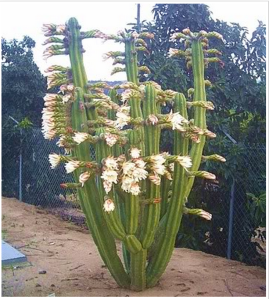
https://marianatschudi.wordpress.com/2013/12/19/the-sacred-cactus-in-ancient-cultures/
unquote
and has a lot of example figurines and such...
quote

cactus and jaguar
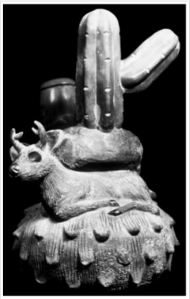
cactus and deer
same site
unquote
I've gone on about the jaguar...follow on yesterday about werewolves...jaguars the shape shifted form of the shaman in an altered state...Mesoamericans have this too...
quote

same site
unquote
sort of the staff god...in his hand I imagine he is holding a stylized emblem of the cactus...I'd just looked close the other day at another drawing with a different plant...hard to find again...
quote
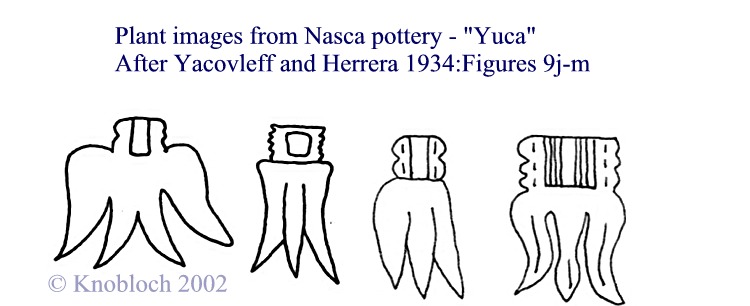
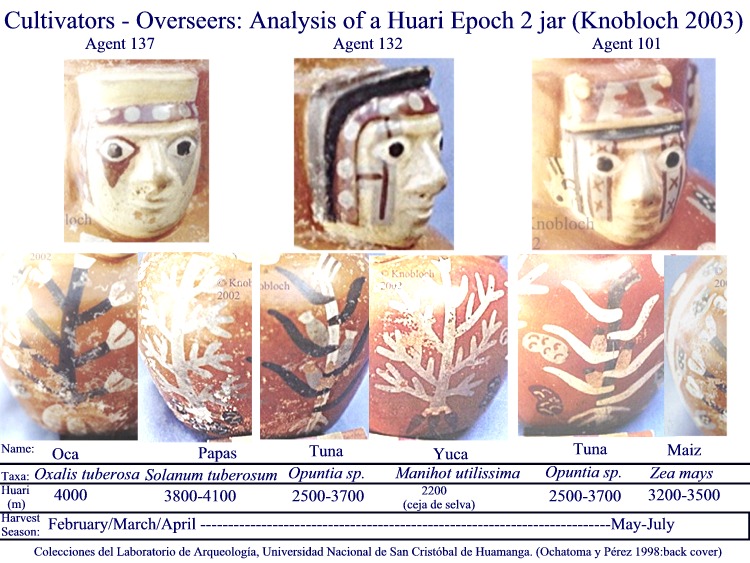
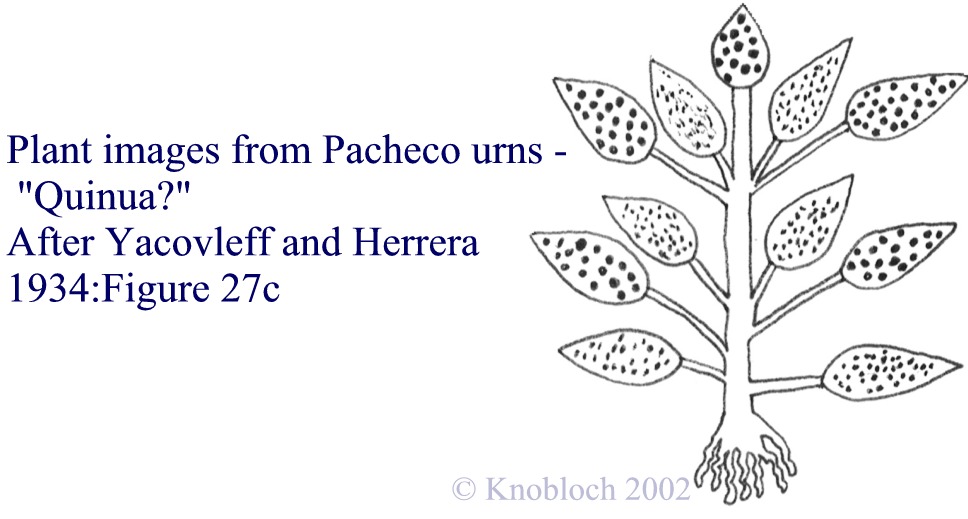
Comments:
unquote
we served Quinoa soup at last chance...stumble everytime I tried to pronounce it!...this next one is the best...
quote
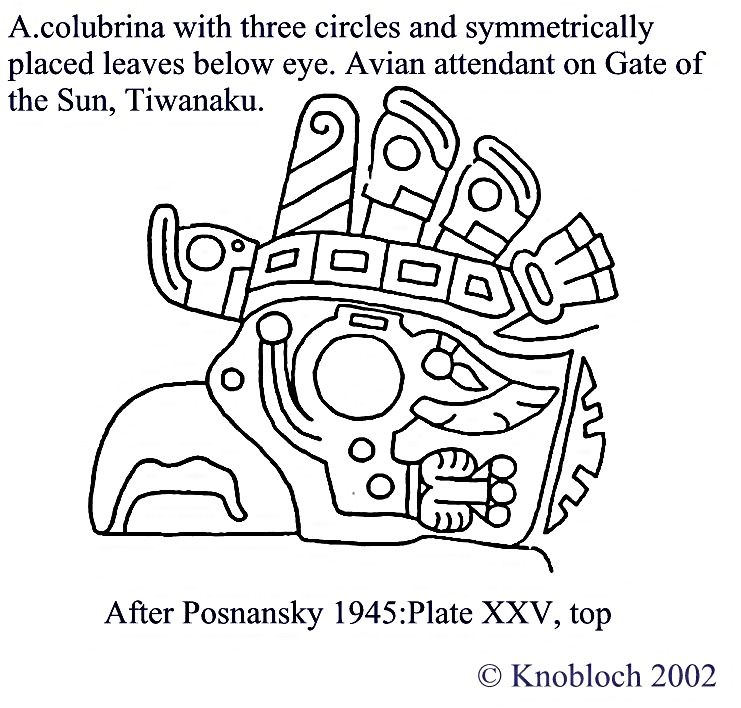
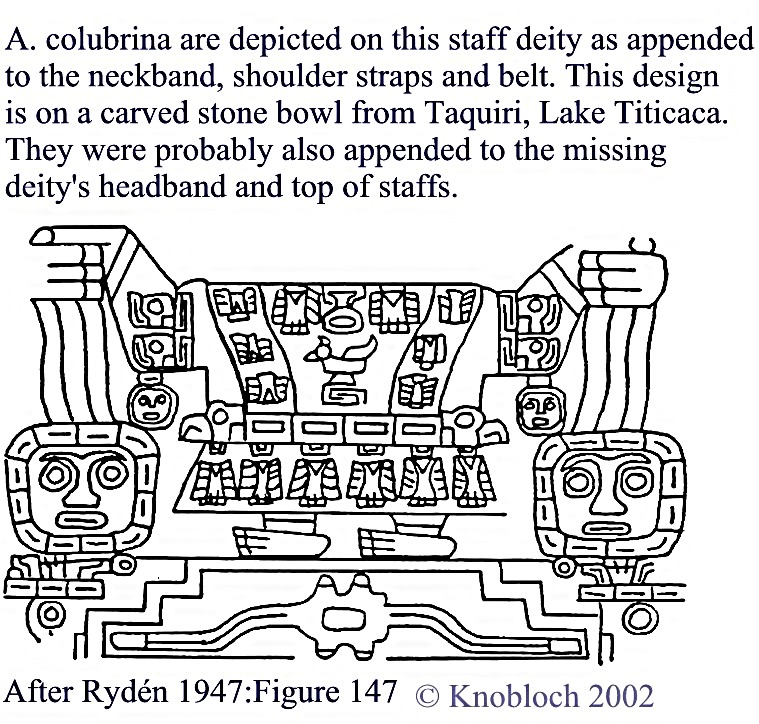
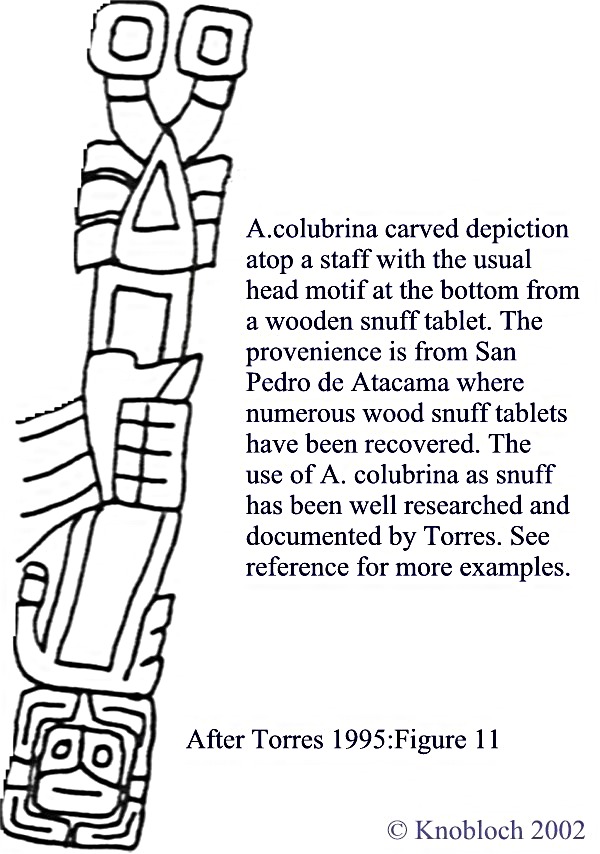
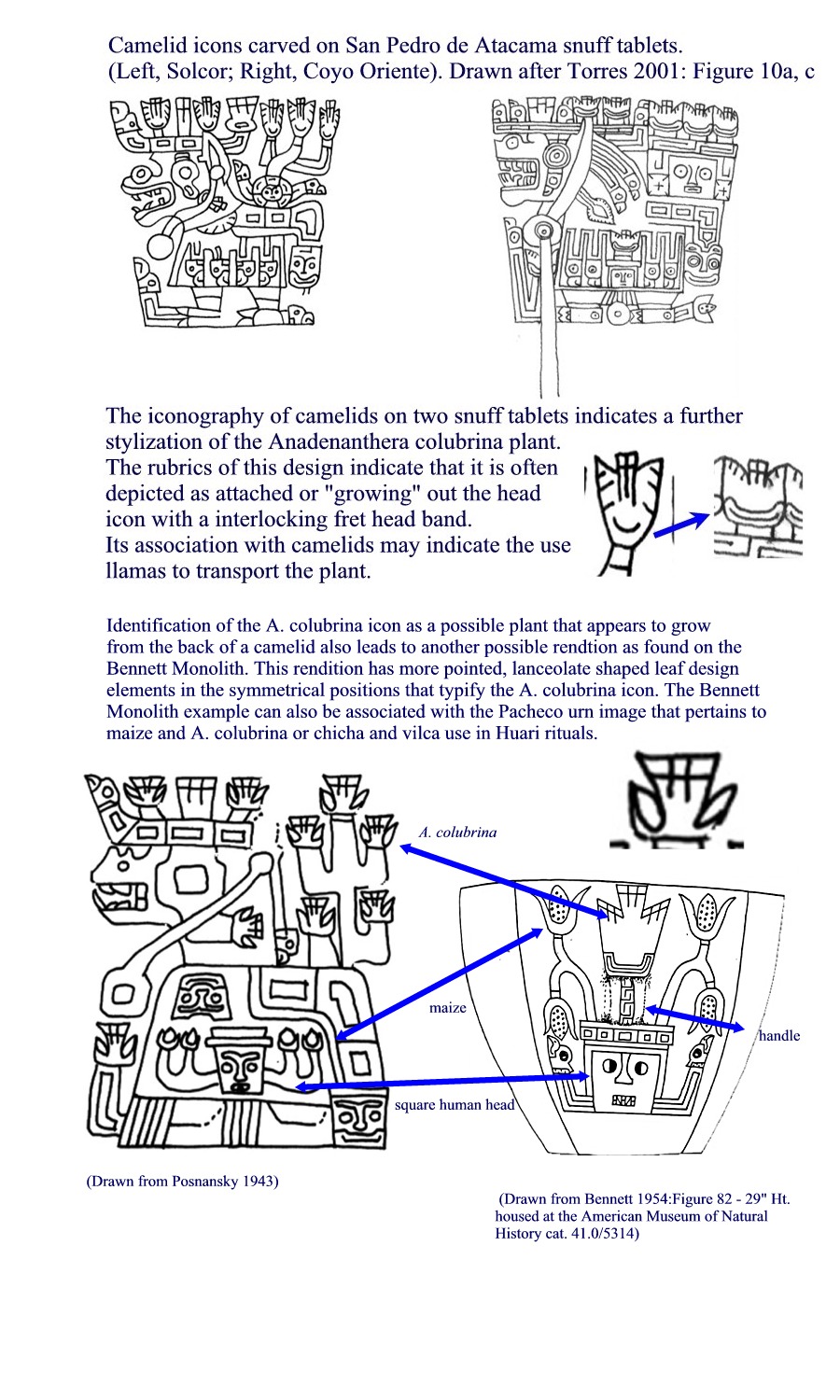
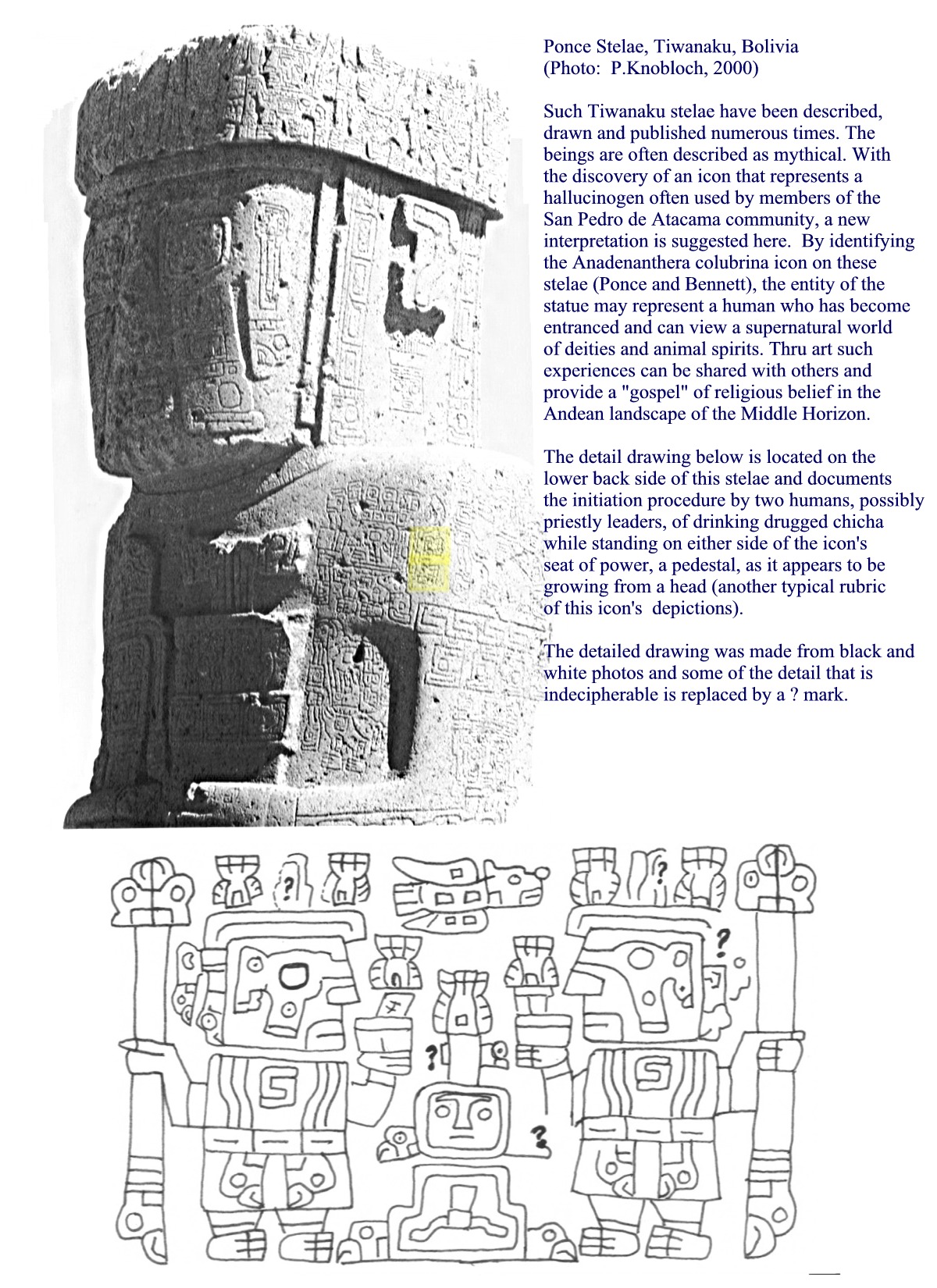
With these known attributes, the plant's ancient antecedents in the Pucara religious iconography can now be identified. Though some artistic ties are obvious among the Pucara, Tiwanaku and Huari cultures, this fully stylized icon on Pucara artifacts suggests that a pan-Andean cult or religion was maintained intact for hundreds of years.
... ... ...
find the occurrence of A.colubrina icons on avian attendants (P100-7) facing an anthropomorphic icon believed to represent a sun god on the "Gate of the Sun" at Tiwanaku, a possible ancient documentation of the mythical use and association of this plant with a sun deity. For those who could decipher the entire iconographic image, such design elements probably represented a unit of information similar to an ideogram or glyph though without the sentence structure of verbal communication.
... ... ...
A. colubrina is known specifically for inducing the illusion of flyingÖ" and that Huari and Tiwanaku iconography is characterized by mythological animal spirits with wings or with wing symbols illustrated closely to this plant's symbol" thereby suggesting the plants ability to transform a walking entity into one that could also fly. This transformation or ability to both walk and fly was initially presented as a cosmological model of the sun deity accompanied across the sky by mythical attendants that appeared in the night sky represented by constellations.
https://whowaswhowari.sdsu.edu/WWWPlantIDICON.html
one wonders about here if the Andeans were astral travelers!...but the author's focus on that one plant, that one 'loose end' untangles some of the 'knot', the tangle of enigmas...she goes on about a lot of plants at that site, intended as a data base for research...should have used a format like the weavers' illustration!...wonder if the San Pedro cactus is among the bunch...can't find it...more on plants and their stylizations for sometime...coaches ask of referees to be 'consistent'...call it both ways, as it were...well, if nothing else, the Andeans artistries are consistent!...so, when one sees inconsistency, it's consistent inconsistency!...
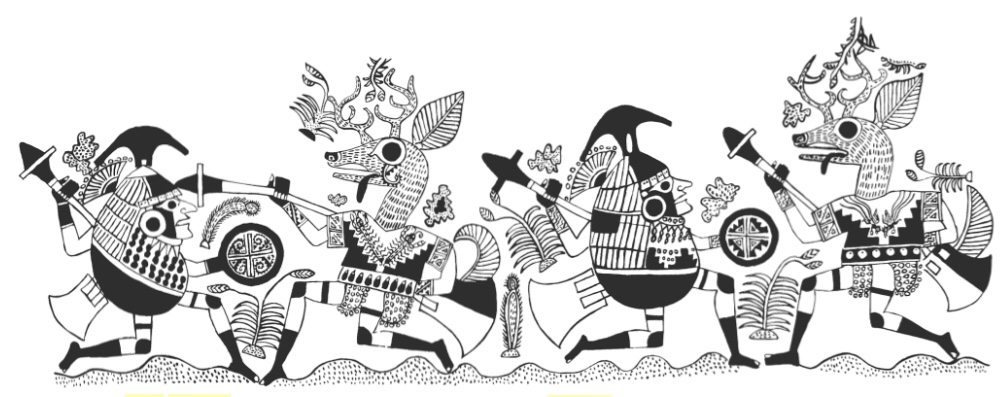
https://traveltoeat.com/moche-deer-hunt/
unquote
oh, good, I found one with both...sorta...at first look the lima bean warriors look identical...but closer looking and the differences show up...as for the deer warriors...well, yeah. there's differences there too!...thought I grabbed a couple exactly alike...familiar as I've become with the step fret, and the step throne/inca warrior checkerboard tunic, I can see those emblems right away...step fret on left warrior's shield...step throne on the right...and there are the maces I just went on about...and there are plants between the legs, and on the antlers...in front of the warriors' noses too...a lot of attention to detail by Moche went into the making of these...and their modern like drawing skills, which extends to their pottery and figurines too, make it easier to see things...these stylizations, these 'canons' were passed on from generation to generation...not an easy thing to do...
quote
Thru art such experiences can be shared with others and provide a 'gospel' of beliefs in the Andean landscape of the Middle Horizon.
from the caption to the Ponce Stellae...see above
unquote
one can zoom in on the web and read the whole caption...I don't know if it is so much a gospel...that comes from our culture, where like the Book Of Days that Queen Elizabeth promoted for the Church of England set out how to get along each day...and it was made to counter the Catholic Church's Book of Days...these are guide books for what priests should go on about each Sunday, and how to perform ceremonies...on a larger scale, how to get along for everyone...I don't know...maybe the Andeans had that...but it sorta looks like they were just really keen about their altered states!...well, I've managed to stave off thinking about the heat wave for awhile!...but the trade off has been being riveted in one position writing, thinking, browsing...web's like that...just locks one into one posture..no physical activity at all...a dream state with that typical dream paralysis of one's limbs!...enough for now...go find a movie with air conditioning...wish I could take Maya my dog...she's found one cool spot on the old porch's cement...usually I have the old door propped open with a cinder block...but she's shoved the block out of the way of the door so it swings semi-shut, shading the afternoon sun...kept putting it back in place, and she kept moving it...so, now just leave it as she likes it!...Oh, Angels play White Sox tonight...get a snack, then go to game...be a bit cooler thereabout...(spelling check and edit when I get back)...hmmph...White Sox 5-3
:)
DavidDavid








No comments:
Post a Comment